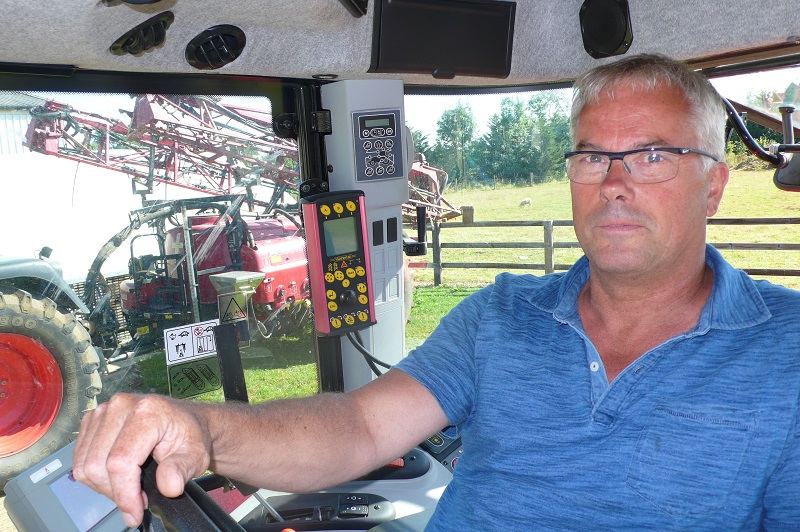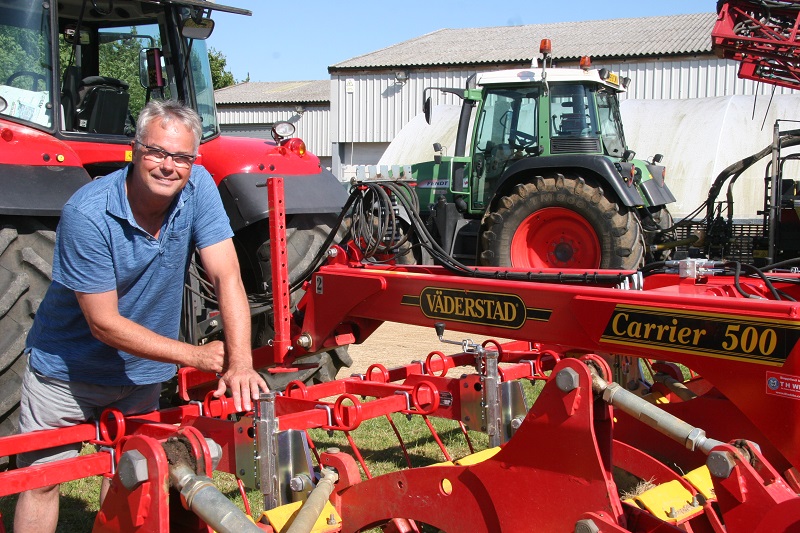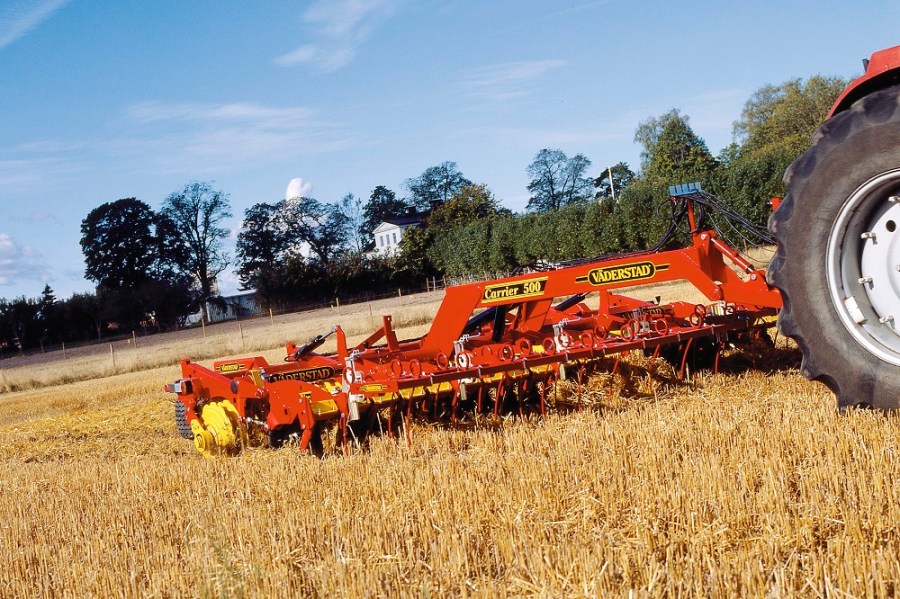Already following best practice advice for cultural control of blackgrass, one Wilts grower is now shifting to ultra-shallow stale seedbeds to prevent the problem escalating. CPM reports.
It’s become clearer now that to control blackgrass there can be no cultivation of the soils below about 50mm.
By Mick Roberts
In common with many arable farmers, Paul Harris has watched with mounting horror as blackgrass levels have increased at his Grove Farm at Leigh, in north Wilts this season. While he thinks it’s still under control, he’s taking immediate steps to ensure it doesn’t become unmanageable.
“I reckon we’re still achieving about 90% control of blackgrass, but in some areas the problem is not going away. This applies particularly to a heavy land field, next to a brook, which flooded last season. I am now determined to prevent it spreading, not get any worse and ultimately bring it completely under control,” he says.

Paul Harris is determined to prevent blackgrass spreading, and ultimately wants to bring it completely under control.
Paul Harris is a keen follower of advice and keeps himself up to date by attending farm visits, technical meetings and studying technical articles. He’s a farmer who reckons he’s doing all the right things to combat grassweeds, but admits he feels he’s still losing the battle.
Flooding losses
The 120ha all arable farm has a wide mix of soil types from Cotswold brash as well as heavy clay on one side of a brook and gravels on the other. Flooding around this watercourse he feels is also getting worse, which means spring cropping makes sense to not only alleviate the cost of crop losses, but also control grassweeds that thrive in this heavy, wet soil.

The Straw Harrow comes in set of banks, each of which are equipped with independent depth adjustment.
“Spring cropping is vital to control blackgrass, but there are other benefits, including lower growing costs. I currently grow Odyssey spring barley on contract for the Crisp Malting Group. If this gets up and away well it also helps to smother blackgrass.
“I stopped growing oilseed rape and switched to Prophet, large blue micronising peas for the pet food industry,” he continues. “But I’m obviously not the only farmer to spot that opportunity – because the price has fallen from £300/t when I started, down to £140/t last year.”
He’s reluctant to stop growing the peas, though, because currently they’re the only proper break in his cropping. “I don’t have a tight rotation set in stone – I tend to look at the crops to suit the conditions, markets and season,” he explains.
Other main crops include J.B Diego winter feed wheat and oats providing a ‘half break’ as well as possibly an allelopathic effect on the blackgrass. He noticed the oats also helped to smother the blackgrass last season. In common with many others, he’s still searching for a good paying break and alternative spring crops, with spring wheat not out of the question.
Cover crops are also being tried, with fodder radish providing a dual purpose role as feed for over-wintered sheep and a way to help dry out the heavy clay land. The deep roots also help improve soil structure.
In fact, there’s little of the latest cultural control advice Paul Harris isn’t now following – he’s tweaking his crops to the season, spring cropping and also late drilling. “I came back to farming in 1999, after working for a dealer and followed a lot of my father’s advice. He said sow barley on 15 Sept and wheat on 15 Oct. So I’ve always drilled late, or at the normal time for me.”
But despite this, he hasn’t escaped the scourge of blackgrass. He’s not sure how it appeared in his fields and isn’t putting much thought to that. He is, however, fixated on making sure it’s not going to spread and is investigating every single option.
Agronomy on the farm is supplied by Hutchinsons and he follows advice from the company’s technical manager, Dick Neale, on creating shallow stale seed beds and minimum disturbance. Indeed, he even refers to his comments on blackgrass control in the July issue of CPM.
“It really confirmed what I was already thinking,” he says. “I’ve recently bought a new Väderstad Carrier specifically to create shallow stale seedbeds, so it was reassuring to know I was following the best practice advice.”
Until last season, the Grove Farm establishment regime comprised minimum tillage, using a 3m wide Väderstad Cultus cultivator to create seedbeds in one pass, while also providing an element of deep loosening, followed by sowing with a 3m Väderstad Rapid box drill.
“While the Cultus does a good job I realised it wasn’t helping to control blackgrass – in fact it could have been making it worse,” he explains. The machine is equipped with heavy ‘spring’ tines fitted with 80mm wide points and wing shares below to cultivate the ground across the whole width. This was being worked to a depth of about 150-175mm.
After realising this was too deep and could be bringing up blackgrass seeds, he switched to using the Väderstad ‘Low Disturbance’ points. These are designed to provide deeper loosening, without bringing fresh soil to the surface, which he hoped to also help improve soil structure and drainage.
“It’s become clearer now that to control blackgrass there can be no cultivation of the soils below about 50mm – all the advice I’ve read and heard says this. The trouble was, even with the narrower Low Disturbance points, the Cultus was still mixing the weed seeds through the profile at depth.
Mixed in profile
“This makes it very difficult to control the blackgrass, which only germinates in the top 50mm of soil. So while I was killing the plants on the surface the seed mixed in the profile remained untouched and viable the next year when it was brought back up by the tines,” he explains.
The only way to stop this vicious circle, he decided, was to confine the cultivations to just surface-deep stale seedbeds. Here the germinated weed seeds can be controlled with a number of passes of glyphosate sprays.
So instead of using the Cultus, h’s now switched to a 5m wide Väderstad Carrier, equipped with a straw rake front tool. “Although I still sell the straw off the field, the rake will help spread any remaining chaff, weed seeds or broken stubble. I set it so it’s just touching the surface – it’s not doing any cultivating,” he explains.
The machine is pulled by a 150hp, Fendt 415 that handles it easily on most soils working at speeds of about 12-15km/h, which he says does a good job.
The depth of the two rows of discs is set with spacers on the hydraulic ram and the penetration of the parallel gangs means it isn’t difficult to set them to work too deep. Sticking to ultra-shallow aims may, he suspects, be slightly tricky in some soils. “I’m going to try to set it to work at 25mm and not change it,” he says.
At the rear, the seedbed is consolidated by the SteelRunner roller, which he adds should help blackgrass to germinate by firming the soil around the weed seeds. He is also thinking of establishing the fodder radish with a BioDrill on the Carrier, which will also benefit from consolidation.
He doesn’t usually aim to use any other cultivation before drilling straight into the stale seedbed with the Rapid box drill. This, he says, will help to keep weed seeds out of the top layer and hopefully they’ll decay at depth over the following years.
“I do, however, rotationally plough, mainly after maize grown on land I’ve rented. But I do heed the advice to plough once and leave it three or four years. I prefer the shallow cultivations because, unlike ploughing, working at 50mm also helps to preserve the worms and microfauna as well as improve the soil structure. I also have green waste compost applied to the soil to replenish the organic matter, mainly on the Cotswold Brash land,” he says.
Last autumn was his first season with new Carrier-based cultivation regime and it was used for establishing the wheat and oats. The work involved one pass with the machine followed by spraying off the stale seedbed with glyphosate.
He also applied Avadex as well as well as a pre-em application, using the Syngenta 3D Defy nozzles on his Case Gem trailed sprayer. He feels the angled nozzles, which are designed specifically for this application, provide the best chance for optimum control.
“Although drilling later means spraying opportunities are more limited and days are getting shorter, I can keep to the timings because although I don’t have much time, I also don’t have large areas to cover,” he explains.
So how did the new system work? “In one field in the brash near Cirencester, which has always had a big blackgrass problem, it’s much less noticeable this year. I also don’t see much in the oats, because I think the crop helped smother it.
“I’m definitely going to keep to the idea of keeping cultivations on the surface and stop mixing the seed through the profile. I don’t have too many compaction problems and although I do have a sub-soiler, I haven’t used it for years. It’s no good on the brash, it just brings up stones; and on the heavier clay land I hope that the soil dries out enough to create natural fissures, which is the ideal way to restructure the soil.
“I can remove some legs from the machine and fit a mole. If the soil is in the right condition to take a mole I may run this through some known wet patches, where the water can accumulate on the surface. Otherwise the only time I’ll use deeper cultivations is before the peas using the Cultus,” he says.
The Carrier can carry a different tool
While the well known Carrier range now includes larger models with more aggressive cultivation discs, the original 45cm disc machine still sticks to its main concept as a tool to create shallow seedbeds. However, recent changes have extended its versatility by adapting its action with the addition of new or existing tools, says the firm’s Andy Gamble.
“It’s now fairly well recognised that it’s not possible to create a proper seedbed to germinate grassweeds using a straw harrow alone. But there’s still a requirement to spread the straw evenly across the surface, to prevent lumps or heaps holding back germination or harbouring slugs,” he explains.
While a straw harrow has been available for a number of years, this is now becoming a more popular option. It simply mounts in front of the machine, in place of the popular CrossBoard, and is equipped with long tines to harrow the straw ahead of the discs.
A new alternative is the CrossCutter knife, which is recommended for mulching surface trash. “It chops brittle material, such as OSR stubble and dry straw, but its main effect is to bash, bruise and damage the remains. This allows the bacteria to enter more easily, which helps it to break down faster and more effectively,” says Andy Gamble.
The CrossBoard provides more aggressive cultivation, levelling the soil and breaking up clods. But with the recent move to finer, shallower stale seedbeds more growers, like Paul Harris, are now opting for the straw harrow instead.
Consolidation in most cases is still provided by the SteelRunner rear consolidation roller. While initially designed for crushing clods, it does also provide good seed-to-soil contact to help promote grassweed germination.
A new option is a single SoilRunner roller. This has U profile rings that are designed to fill with soil in operation providing soil to soil packing, which is said to leave an open, cultivated surface. The design also helps prevent clogging in wetter conditions, explains Andy Gamble, and some growers prefer to leave the open surface on land that’s going to be left a while before drilling.
For light to medium soils is the RubberRunner roller. Although not as popular as the steel version, this does provide another option for those looking for good consolidation with reduced draft.
The Väderstad BioDrill can also be mounted to all Carriers from the 300 up to the 1225. While first introduced for sowing small seeds, it distributes the seed in front of the packer, providing good seed-to-soil contact. Interest in this option is increasing among those looking to establish cover and catch crops with the Carrier.
Farm Facts
Grove Farm, Leigh, Wilts
- Area: 120ha – all arable
- Staff: Paul Harris
- Cropping: winter wheat (JB Diego), winter oats (Gerald), spring barley (Odyssey), large blue peas (Prophet plus trials of Campus), fodder radish for cover crop/feed, stubble turnips for sheep feed
- Tractors: Fendt 415; Massey Ferguson MF 7480
- Combine: New Holland TX62
- Sprayer: 18m Case Gem, trailed 2600 litre
- Spreader: Kuhn Axis
- Drill: 3m Väderstad Rapid box drill
- Cultivation equipment: 5m Väderstad Carrier, 3m Väderstad Cultus, 6m Väderstad rolls




